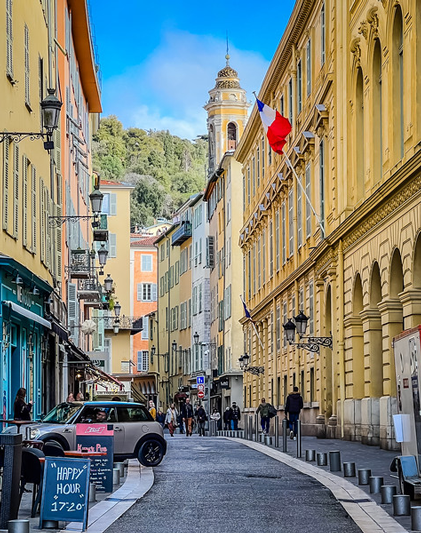Visiting Sisteron? Don’t miss the Cathédrale des Pommiers! This 12th-century Romanesque building, also known as the Cathedral of Notre-Dame and St. Thyrse, will captivate you with its sober architecture and remarkable Lombard details. We particularly appreciated the harmony of its proportions and the serenity that emanates from its interior spaces.
In this article, you’ll find some useful tips to help you prepare for your visit and have a wonderful time!

This guide is completely independent, based on our experiences. We visited the region anonymously, making our own choices and paying our bills in full.
Why visit the Cathédrale des Pommiers in Sisteron
Is the Apple Tree Cathedral worth it? Our opinion:
Yes, you absolutely must enter this Romanesque cathedral, which bears witness to the religious art of the 12th century with remarkable sobriety. Its Lombard details, carved shells in the apses and historic Merklin organ were particularly striking features of our discovery.
In our opinion, this is one of Sisteron’s best activities.

Why is the Cathedral of the Apple Trees famous?
The Cathedral of the Apple Trees is renowned for its remarkably well-preserved Romanesque architecture and its Lombard details, which are unique in the region. It also owes its fame to its eventful history, having survived the destruction of the Wars of Religion in the 16th century, although its original bell tower was destroyed in 1564.

Our favorite moments
We particularly appreciated it:
- The Lombardy details on the western façade and, inside, even in the choir, bear witness to the Italian influence in the region.
- The carved shells in the absidioles are real gems.
- TheMerklin organ, built in 1888, still resonates in the nave for certain masses and concerts.

History in brief
Here are the key dates in the history of the Cathédrale des Pommiers:
- 12th century: Construction of the Romanesque cathedral
- 1564: Destruction of the original bell tower during the Wars of Religion
- 17th century: Reconstruction of the belfry
- Post-medieval period: Addition of side chapels after destruction of the cloister
- 1888: Merklin organ installed

Access and map: Cathédrale des Pommiers, Sisteron
Where is the Cathédrale des Pommiers?
The Cathédrale des Pommiers is located in the center of Sisteron.
- At the foot of the Citadel
- Opposite the Town Hall and Tourist Office
OUR TPS FOR RENTING YOUR CAR IN Provence
- Compare prices on our preferred platform: DiscoverCars – one of the best rated sites.
- Choose a car that is powerful enough (the roads are steep) but compact (some passages are narrow).
- Think of thecomplete insurance (some roads are tortuous and narrow).
- There is a lot of demand, book it early.

How to get there?
- Sisteron is mainly accessible by car from the region’s major cities.
- Public transport also serves Sisteron from neighboring towns.
- The cathedral is then within easy reach.
- For a more touristy approach, you can opt for organized tours that often include a visit to the citadel and historic center.

Parking
- Several parking options are available in Sisteron’s historic center.
- We recommend Parking Place de la République, just opposite the cathedral.
- A few spaces are also available just outside the entrance to the building.

Useful tips: duration, schedules, eating…
Best time to visit
- We recommend visiting the Cathédrale des Pommiers in the late morning or early afternoon, to take advantage of the best possible lighting to highlight the Romanesque architecture.
- The spring and autumn months offer ideal conditions, with soft light that sublimates the sculpted details.
- However, we advise you to check the Mass times before your visit.

Length of visit and main difficulties
- Allow 45min to 1h for a complete visit.
- Access is on one level and presents no particular difficulties.
- The building is not usually crowded, making for a peaceful visit.
- Accessibility for people with reduced mobility is via the main entrance.

Advice on how to visit
We recommend starting by observing the western façade and its Lombard details, then entering through the main portal to appreciate the nave and aisles. Then head to the choir to admire the apses and their decoration, before finishing with the Merklin organ and the side chapels.

A LITTLE MORE patience
All the photos, maps, information, good addresses to make your stay in Provence a success, will soon be gathered in a single ebook!
If you wish to be informed of the publication of our guide on Provence, subscribe:

Schedules and rates
- Opening times vary according to the season. We recommend that you check opening times with the Sisteron tourist office here, especially in winter when opening times may be reduced.
- Access is free of charge.

Guided tours
- Guided tours of Sisteron’s heritage can be organized on request.
- No specific audio guide is available, but explanatory panels help visitors understand the history and architecture of the building.
Catering
Several dining options are available in Sisteron’s historic center, just a few minutes’ walk from the cathedral. We haven’t yet tested the restaurants on site, but on our list are Restaurant Il était une Fois and Restaurant Le Canap.

Subscribe to our Newsletter
- Get away from it all with Region Lovers’ beautiful destinations!
- Once a month
- Advertising-free
Remarkable architecture and exterior
Façade and exterior decorations
The western facade of the Cathédrale des Pommiers immediately caught our eye, with its imposing sobriety typical of 12th-century Romanesque art. We paid particular attention to the semi-circular portal featuring three elegant voussoirs supported by finely sculpted colonnettes.

You’ll notice the Lombard details that enrich the architectural ensemble, testifying to the Italian influences in this region. The luminous oculus above the gate adds a touch of elegance to this harmonious composition, creating a subtle play of light that varies according to the time of day.

Bell tower and history
The history of the bell tower of the Cathédrale des Pommiers reminds us of the turbulence of the Wars of Religion that marked the 16th century. We learned that the old bell tower, destroyed in 1564, bore witness to the building’s original grandeur. The current belfry, rebuilt in the 17th century, takes a more discreet approach, contrasting with the imposing original tower.

You’ll discover in this reconstruction the expression of an era marked by prudence, when religious architecture had to balance spiritual affirmation and preservation in the face of conflict. This architectural transformation perfectly illustrates the resilience of religious heritage in the face of the trials of history.
Chapels and extensions
The addition of side chapels to the Cathédrale des Pommiers reveals the evolution of religious architecture over the centuries. We have observed how the five chapels added to the south and the three to the north blend harmoniously into the original Romanesque structure, despite the destruction of the cloister that preceded their construction.

You’ll notice that these extensions feature a variety of alignments and depths, creating a distinctive architectural rhythm that enriches the building’s silhouette. This adaptation testifies to the continuing vitality of the religious community and its ability to adapt the sacred space to suit liturgical needs, while respecting the integrity of the original Romanesque work.
Interiors and treasures to discover
As we entered the Cathédrale des Pommiers, we were struck by the sheer size of the central nave, with its barrel vaulting, a technique typical of late Romanesque architecture. The generous width of this space contrasts harmoniously with the narrowness of the surrounding aisles, creating a perspective that naturally guides the eye towards the choir.

You’ll appreciate the bright, sober ambience that reigns in these uncluttered volumes, particularly conducive to contemplation. The alternation between the shadows of the aisles and the light of the main nave creates a soothing visual rhythm, testifying to the mastery of the Romanesque builders in the art of creating spiritual spaces imbued with serenity.

Apse and dome
The cathedral’s central apse, vaulted in the Romanesque cul-de-four tradition, is the architectural jewel in the crown. We were particularly impressed by the side absidioles, adorned with sculpted shells – remarkably fine decorative details that testify to the refinement of Provençal Romanesque art.

You’ll also discover the trumpeted cupola that marks the entrance to the choir, built on an imposing octagonal mass. The subtle alternation of dark and light stones in this construction creates a striking chromatic effect that underlines the liturgical importance of this space. This natural polychromy, the result of a judicious choice of local materials, lends the ensemble an exceptional visual richness.

Historic furniture and organ
The Merklin organ, installed in 1888, is a veritable heritage treasure at the Cathédrale des Pommiers, with 17 stops on 2 manuals and a pedalboard. We were impressed by the quality of preservation of this instrument, which continues to resonate at celebrations and concerts.

You’ll experience how this period furniture, perfectly integrated into the Romanesque architecture, creates a temporal harmony that unites the different periods in the building’s history. This continuity in liturgical design testifies to the constant vitality of this place of worship over the centuries.

Frequently asked questions
Why is it called the Cathedral of the Apple Trees?
The name “Cathédrale des Pommiers” originates from an alteration of the Latin word pomerium, which in ancient times referred to the open space between ramparts and dwellings. As the cathedral was built in this area in Sisteron, its name has remained associated with this term, gradually deformed into “apple trees”.




